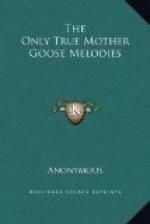I have asked and asked and have received no answer, as to the artist who made many of the admirable designs which are distinctive in this book. Abel Bowen’s[*] name is signed to one, and his initials appear on several. N.D. means Nathaniel Dearborn[+]. One is signed “Chicket,"[&] but this does not account for the greater number of them. I was the son of a printer and type-founder, so we had a “type book” as a classic in our nursery. So I knew even as a little child, that there were pictures in Mother Goose which were put there merely because the block from which they were printed existed in the printer’s office. But there were other designs made by some artist of genius; and who was he? He represented the man in the moon, hanging with one arm to the crescent of the moon. That man, whoever he was, is to be ranked among the original artists of the world. He gave to childhood his first and best images of the blackbirds who were baked in the pie.
[*][Note from Brett: Abel Bowen (1790-1850) was Boston’s first wood engraver and is perhaps most well known for his work on the “Farmer’s Almanac.”]
[+][Note from Brett: Nathanial Dearborn (1786-1852) was with the Holland Printing Company and is perhaps most well known (in 2002) for the difficulty he had in setting plates for a 13 cent stamp used in Hawaii (second issue). He also was a printer and author of “The American Textbook for Making Letters.” He would have been well remembered in Boston at the time of this book.]
[&][Note from Brett: “Chicket” is terribly obscure and the only reference I could possibly find was to a Mr. Chicket who was apparently murdered in a bar (the Brushmakers Arms) in Upham, New Hampshire and supposedly haunts the bar. Whether this has anything to do with the Chicket in the text is highly questionable, but would make for a great story.]
This question I have asked again and again, and no man and no woman has answered it. But the chances seem to be that we owe them also to Abel Bowen, the first wood engraver recorded among the engravers in the period after the Revolution. We have specimens of his work more in pictures of landscape or of buildings than in drawings of men and women. But there can be but little doubt that most of the blocks from which the Mother Goose of our childhood were printed were engraved by him, and there seems to be good reason to believe that the designs were by him as well. The pity is that no old portfolio can be found with other designs from his pencil. But, alas, the chances are that they have gone where so many other manuscripts have gone, which would delight the antiquaries.
Thanks to the publisher and editor of this book, the designs, of whatever hand, are now preserved for another generation.
I have said that I am not learned in the interesting genealogical discussion of the subject, but I like to call attention to the fact that the English Norwich was the birthplace and home of Fleet, and that it is possible that in the annals of that city light may be gained as to the history of the man in the Moon.




